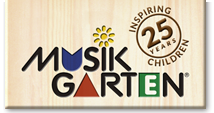The series The Neuroscience of Music* shows parents and music teachers ways in which early childhood music education can help impact the development of children. This second set of the Wish List series focuses more specifically on a parent’s School Skills Wish List. The topic of the third installment of this set is how to get children to enjoy practicing.
From infancy to about the age of 6, children have a unique window of opportunity to learn how to, and enjoy practicing things. Dee Joy Coulter, a nationally recognized Neuroscience educator, explains that during these few years, a child’s enjoyment of repetition is strong. Parents can help them to practice naturally by providing fun activities that they can eventually master. However, this satisfaction must come from within in order to develop a lifelong habit, warns Coulter, so parents must resist praise, blame or pressure during these activities.
Below are ways that parents and early childhood music educators can use music to help children learn to develop self-discipline to succeed at school, work, athletics, and the arts.
How to introduce the idea of practicing to infants and toddlers
- For infants and toddlers, imitation is the primary and most efficient mode of learning.
- In learning basic coordination and language, infants must practice and learn the nuances of their senses in a pleasing way. They are wired to mirror everything they see, and this is highly rewarding to them. Parents and early childhood music teachers can help with imitation games with clapping and pointing to things with exaggerated facial expressions, and they will naturally follow and copy.
- In the earliest stages of infancy to toddlerhood, parents can perform simple songs and movement games to teach motor skills and instill a familiarity. After a few weeks of repetition, leave a particular game for a few weeks and come back to it. This allows the infant or toddler time to anchor the movements and memory in their system. When the game is brought back, the predictability that goes with recognition and the control that goes with increased physical mastery are very powerful incentives for practicing.
How to teach preschoolers to begin focusing on how to practice
- Research suggests that poor learners don’t know how to handle the failures of new learning, and so tend to abandon challenges right away for fear of failure. On the other hand, those that excel in tasks and challenges tend to have a passion for practice and truly enjoy the experience – much like the capacity of children’s minds in the first stages of life.
- Share enjoyable music activities with your preschooler before introducing an instrument. By first instilling a love of music in children before asking them to focus on an instrument helps to ensure that they will enjoy practicing due to its relationship to something they already love.
- The teaching practice of spiraling, or a pattern of dropping an activity for a period and then spiraling back to it, allows new skills to seat more deeply than constant practice. Childhood music programs will use this practice along with the process of scaffolding to allow children to learn on their own and provide help at the appropriate times. This approach to creating the basis for more advanced learning is important for advancement in musical skills, mathematics, science and foreign language learning.
Music can be an important tool for preparing infants and toddlers for a lifetime of learning enjoyment. Games that encourage mimicking help to develop a love for practicing from the earliest stages of infancy. By leaving and returning back to activities, children will learn to think and accept new concepts on their own while having pleasure in practicing. This will not only serve them well in music, but also in academics.
*Musikgarten Delivers: The Neuroscience of Music collection by Dr. Dee Coulter is available for $10 in the Product Catalog section of our Teacher Portal. Username and password are required. You may also contact Musikgarten at 800-216-6864 to purchase.





